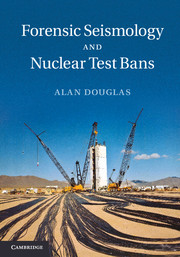Book contents
- Frontmatter
- Contents
- Preface
- Abbreviations and mathematical symbols
- Prologue
- 1 Seismology: ancient and modern
- 2 Statistical solutions to seismological problems
- 3 Seismograms as time series
- 4 Seismographs and seismograms
- 5 Seismometer arrays and processing methods
- 6 Seismogram interpretation and synthesis
- 7 Hypocentres and P travel times
- 8 Seismic magnitudes
- 9 Seismic source identification
- 10 Epilogue
- Appendix A P and S radiation from a double-couple source
- Appendix B Normal equations for analysis of variance
- Appendix C Some uses of the FFT
- Appendix D Anelastic attenuation
- Appendix E The relation of the transient and steady-state responses
- Appendix F Seismometer–galvanometer systems
- Appendix G SNI from summing array recordings
- Appendix H The equations for computing MP filters
- Appendix I Circular arrays
- Appendix J Geometrical spreading when S reflects as sP
- Appendix K The Fourier integral for a dispersed wave train
- Appendix L Tables of explosions and earthquakes
- Appendix M Album of body-wave seismograms
- Appendix N Exercises
- References
- Further reading
- Author index
- Index
3 - Seismograms as time series
Published online by Cambridge University Press: 05 March 2013
- Frontmatter
- Contents
- Preface
- Abbreviations and mathematical symbols
- Prologue
- 1 Seismology: ancient and modern
- 2 Statistical solutions to seismological problems
- 3 Seismograms as time series
- 4 Seismographs and seismograms
- 5 Seismometer arrays and processing methods
- 6 Seismogram interpretation and synthesis
- 7 Hypocentres and P travel times
- 8 Seismic magnitudes
- 9 Seismic source identification
- 10 Epilogue
- Appendix A P and S radiation from a double-couple source
- Appendix B Normal equations for analysis of variance
- Appendix C Some uses of the FFT
- Appendix D Anelastic attenuation
- Appendix E The relation of the transient and steady-state responses
- Appendix F Seismometer–galvanometer systems
- Appendix G SNI from summing array recordings
- Appendix H The equations for computing MP filters
- Appendix I Circular arrays
- Appendix J Geometrical spreading when S reflects as sP
- Appendix K The Fourier integral for a dispersed wave train
- Appendix L Tables of explosions and earthquakes
- Appendix M Album of body-wave seismograms
- Appendix N Exercises
- References
- Further reading
- Author index
- Index
Summary
… theory is like garlic in that there is no such thing as a little of it.
A History of Mathematics C. B. BoyerIntroduction
At the beginning of the AWE research programme all recording was in analogue format – the continuously varying voltage out of the seismometer and the associated electronics were encoded as a continuously varying magnetic intensity on tape. Although analogue does not have the flexibility of digital recordings, much was achieved by AWE Blacknest with an analogue computer, supplemented by analogue devices including special-purpose tape loops, hardware filters and so on.
A consequence of the UK's early reliance on analogue recording is that AWE Blacknest has made little use of spectra. Spectra are most easily estimated from digital seismograms. Until the mid-1970s the group had no easy access to digital seismograms, so the seismologists learnt to interpret seismograms in the time domain and even when AWE Blacknest switched to digital recording, spectra were rarely used. Elsewhere, and particularly in the USA where digital seismograms were available from the mid-1960s, amplitude spectra have been much used.
One weakness of the reliance on the amplitude spectrum is that half the information in the original seismogram – the phase spectrum – is ignored, at least for body waves. This is perhaps understandable as interpreting the two spectra – amplitude and phase – together, is difficult. There is, of course, a way of taking account of the two spectra simultaneously and that is by interpreting the original seismogram.
- Type
- Chapter
- Information
- Forensic Seismology and Nuclear Test Bans , pp. 72 - 120Publisher: Cambridge University PressPrint publication year: 2013



